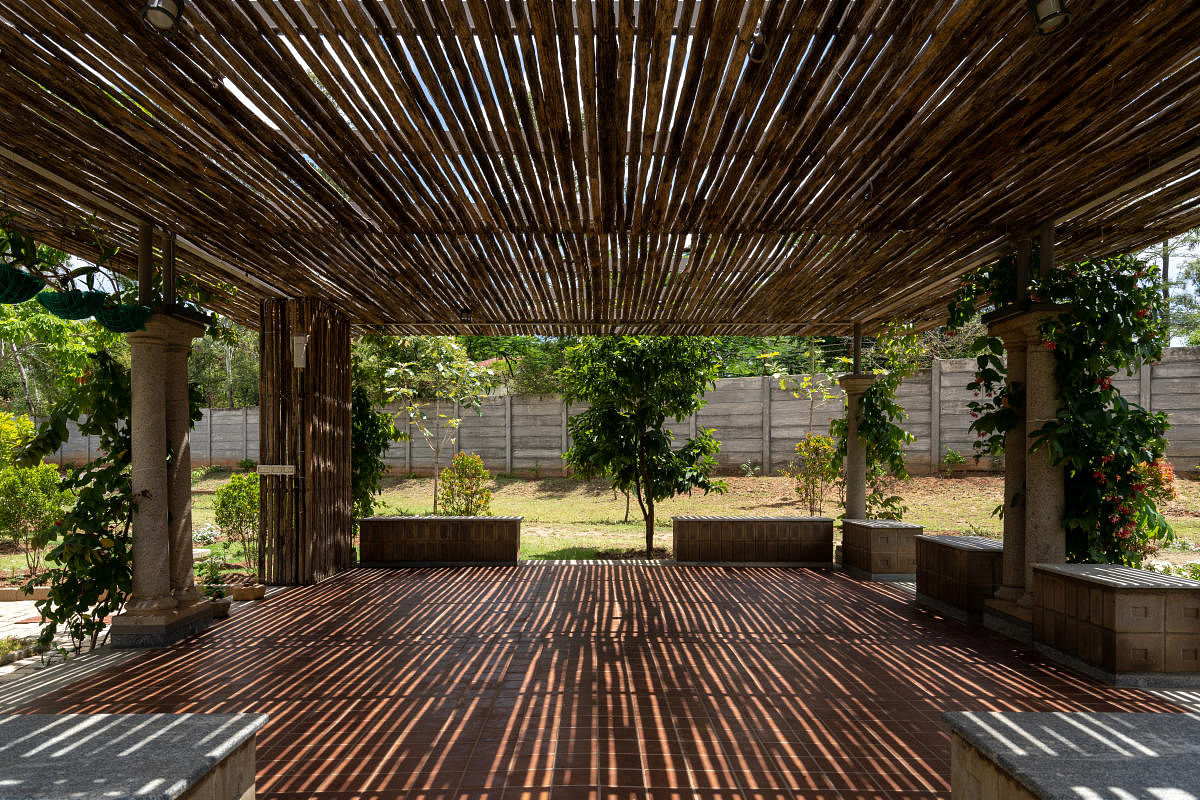

Outdoor structures that add great style and shade: pergolas (a lattice-like feature) and gazebos (unlike pergolas, these have closed roofs) are turning into garden must-haves. People choose these spaces as their getaway spots at home.
How do you decide the size, style, and materials? Architects take us through the different design options.
Climate and design language
Vinay Mavinakere, principal architect with Sudaiva Studio, Bengaluru, points out that studying the climatic response of the place is important. Try and place your pergolas and gazebos in the northeast quadrant (the cooler section) of the garden.
Prathima Seethur, principal architect with Wright Inspires, Bengaluru, created an enchanting semi-shaded pergola with the barks of areca trees for a residential project in Hosur. “We opted for areca over a thatched roof as Hosur has hot summers and a thatched roof could catch fire,” she explains.
While setting up pergolas and gazebos, keep the context and views in mind, says Deepthi C B, a landscape architect with Dharitri Landscape, Bengaluru. At the Maayaa Riverside villas and resorts (an Anaikatti project), she worked in a tropical context: there was plenty of rainfall and lots of greenery.
Here the gazebo overlooks a river, so to prevent flooding and see elephants in the wild, it was raised from the ground using mild steel poles. Inspired by the cottages around and to cover the space from the rain, we added a thatched roof, she says.
For the flooring, Deepthi opted for terracotta tiles that play well with the greenery around. You can use this space as a breakfast nook or throw some cushions and use it as a reading room, she adds.
At Kundhanahali Estate, an ongoing project in Coorg, George E Ramapuram, managing director of Earthitects, Bengaluru, is working on a similar design to create tree top gazebos. “You can remodel the machan concept (a platform used to view animals) and create an intimate dining space within a gazebo that encircles a tree and captures a beautiful view. Here, opt for candle lights, to get an authentic watchtower experience,” he explains.
Different looks
Architect Geeth Gopinath, Vinay’s colleague, says, “The design we choose must blend with the theme of the place, the architecture of the surrounding built area, and the landscape, and not look forcefully fit in.” A Kambipura villa project by Sudaiva studio (GoodEarth Malhar) features a gazebo made with silver oak logs and a thatched coconut tree leaf roof.
“Since this was an earthy context, we opted for rustic materials,” he says. If you want to give your garden walkways or terraces a quick makeover, you can create open pergolas (with just horizontal members made from wood or bamboo poles) cloaked with flowering climbers.
Kiran Hanumaiah, principal architect with Design Matters, Bengaluru, says a flat pergola made from laser-cut mild steel sheets and wrapped with FunderMax is his go-to design for contemporary terraces or rooftop gardens. You can add glass to cover from the rain.
For a vernacular aesthetic, Kiran suggests that you use Mangalore tiles with glass inserts staggered on mild steel members, to create interesting light patterns.
George adds that it’s always clever to use materials and colours from the landscape. If you are building in Hampi, use Hampi’s stone, he notes. “That takes us closer to what god intended for that place,” he adds.
At an Earthitect’s project: Evolve Back, Hampi, George created a royal view from a gazebo illuminated by soft lights. The design was inspired by the ancient Zenana enclosure of the Vijayanagara Empire, the palatial deck with a ‘Mantapa’ overlooks a pool with a stunning view of the rugged forest and boulders that form its backdrop. When you place a gazebo or a pergola in a garden, the view from the house should not be disturbed. Look for non-built spaces, try and place them in the corners unless you have a large plot, he advises.
Function and scale
At her Anaikatti project (Maaya), Deepthi created an arc-shaped Gazebo to facilitate small gatherings in a bonfire and barbeque space beside a pool. To host group dinners or games, keep it circular and large.
In an urban context like Bengaluru where you have smaller plots, lesser privacy, and pollution outside, Prathima opines that having a wholly outdoor space could be counter-productive. Here we opt for terracotta jaali-pergolas on terrace gardens, rooftops, or central courtyards to bring the joys of the outdoors — breeze and sunlight to the indoors, she adds. Prathima created one such pergola at the Suvarna-Deepak, home re-architecture project, Bengaluru.
Maintenance
Natural stones need no maintenance
Paint your bricks, terracotta materials, and clay tiles once in 4 years, or add weather coats if you prefer the crisp and neat look over the mossy look. Of late, many clients are opting for the worn-down look as well, says Deepthi.
Create large overhangs to protect wooden poles
Design challenges
Arranging small scale supply of different materials is a challenge.
With creating such unique spaces, creativity is put to test always.
Wallet factor
Depending on the design and size, the cost of building a gazebo would range from Rs 3-15 lakh.
To set up a pergola space, set aside Rs 2,000 per sq ft.